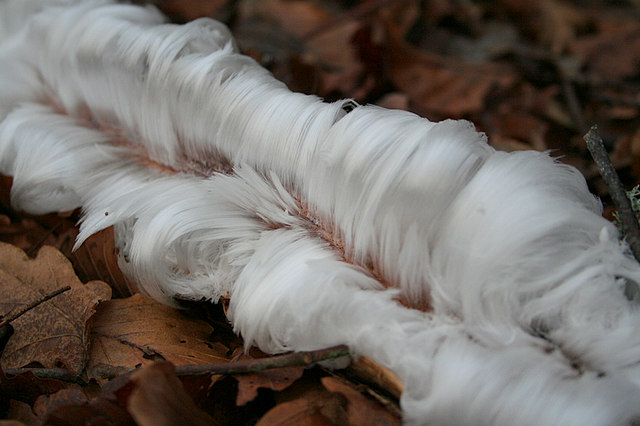The remarkable "hair ice" - a type of ice that grows on dead wood under certain winter conditions and looks more like cotton candy than ice - has been found to be formed by the fungus Exidiopsis effusa.
"When we saw "hair ice" for the first time on a forest walk, we were surprised by its beauty," said Christian M?tzler from the Institute of Applied Physics at the University of Bern in Switzerland. "Sparked by curiosity, we started investigating this phenomenon, at first using simple tests, such as letting "hair ice" melt in our hands until it melted completely."

"Hair ice" - a rare type of ice named after its peculiar string-like form - has been found to interact with a specific species of fungus that is one its core driving mechanisms. Image credit: Des Colhoun via geograph.org.uk, CC BY-SA 2.0.
To figure out the conditions required for "hair ice" to form, M?tzler teamed up with a few colleagues from Germany (a chemist Diana Hofmann and a biologist Gisela Preu?) and subjected it to a battery of tests.
The new research builds on past studies that identified mycelium (the vegetative part of fungus) to be present on wood where this type of ice grows, and showed that dunking it in hot water or spraying it with fungicide prevents "hair ice" from forming.
Now, almost an entire century later, M?tzler and his team set their sights on pinpointing the exact mechanism and fungus species that drive the growth of these beautiful icy filaments.
For her part, Preu? examined samples of hair-ice-bearing wood, collected in German forests during the winters of 2012, 2013 and 2014. Looking at the samples through a microscope she identified 11 different species of fungi. "One of them, Exidiopsis effusa, colonised all of our hair-ice-producing wood, and in more than half of the samples, it was the only species present."
Meanwhile, M?tzler performed a series of experiments, which confirmed the guesses of other researchers that the physical mechanism behind these fascinating growths is ice segregation, where cold water continually builds on the presence of ice. The pores at the wood's surface trap liquid water between the wood and the ice. Suction causes the water to navigate to the outer layer of ice, where it freezes. The presence of fungi is the ingredient that encourages ice segregation to form hair-like strands, rather than a crust.
"The same amount of ice is produced on wood with or without fungal activity, but without this activity the ice forms a crust-like structure. The action of the fungus is to enable the ice to form thin hairs - with a diameter of about 0.01 mm - and to keep this shape over many hours at temperatures close to 0°C. Our hypothesis includes that the hairs are stabilised by a re-crystallisation inhibitor that is provided by the fungus."
Hofmann then studied the "hair ice" itself by melting it and examining its chemical properties. What she found was that the resulting water contained lignin and tannin - complex organic compounds produced by fungus – which suggests that Exidiopsis effusa and the compounds it produces might be responsible for preventing the formation of large ice crystals at the wood surface.
The reason proposed for why it took nearly a 100 years to find evidence in support of the initial hypothesis is the rarity and fleeting nature of "hair ice", found in broadleaf forests at latitudes between 45 and 55°N. "Hair ice grows mostly during the night and melts again when the sun rises. It's invisible in the snow and inconspicuous in hoarfrost," explained Preu?.
The study was published July 22 in the science journal Biogeosciences.
Story Source:
The above story is reprinted with permission of Technology.